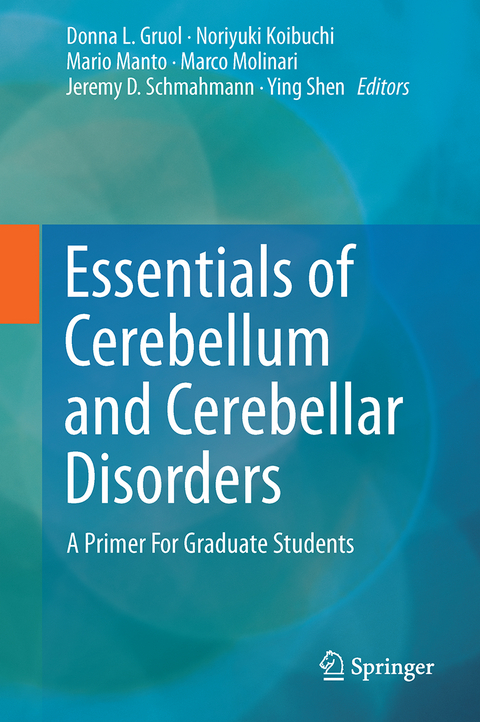
Essentials of Cerebellum and Cerebellar Disorders
Springer International Publishing (Verlag)
978-3-319-24549-2 (ISBN)
- Titel erscheint in neuer Auflage
- Artikel merken
International panel of editors: the 6 editors have a strong experience in research and/or in the clinic. They all devote most of their time to cerebellar research and have regular teaching duties for several of them. Through their networks, their students and the attendance to international conferences, they will contribute to a fast dissemination of the book. International panel of authors: the book will gather an international panel of scientists who are key-players in the field. They are located in USA, in Europe and in Asia. Many of them have contributed to the Handbook and we also aim to attract novel authors or young talented scientists. The authors will come from the best clinical centers, universities or research centers in the world.
lt;p>1. INTRODUCTION
2. BRIEF HISTORICAL NOTE
2.1.A brief history of the cerebellum
2.2. The Contributions of Gordon Holmes and Olof Larsell
3. ANATOMY AND HISTOLOGY OF THE CEREBELLUM
3.1 Gross anatomy of the cerebellum
3.2 Vascular supply and territories of the cerebellum
3.3 The olivocerebellar tract
3.4 Pre-cerebellar nuclei
3.5 Vestibular nuclei and their cerebellar connections
3.6 Spinocerebellar and cerebellospinal pathways
3.7 Visual circuits
3.8 Connectional anatomy of the cerebrocerebellar system
3.9 Cerebello-cerebral feedback projections
4. EMBRYOLOGY AND DEVELOPMENT OF THE CEREBELLUM
4.1 Cerebellar neurogenesis
4.2 Zones and stripes
4.3 Specification of cerebellar neurons
4.4 Cerebellar nuclei development
4.5 Development of glutamatergic and GABAergic synapses
4.6 Synaptogenesis and synapse elimination in developing cerebellum
4.7 Cerebellar epigenetics: Transcription of microRNAs in Purkinje cells
5. CEREBELLAR CIRCUITS: BIOCHEMISTRY, NEUROTRANSMITTERS AND NEUROMODULATION
5.1. granule cells and parallel fibers
5.2. Purkinje neurons
5.3. Stellate cells
5.4. Basket cells
5.5. Golgi neurons
5.6. Lugaro cells
5.7. Unipolar brush cells
5.8. Glial cells
5.9. GABA pathways and receptors
5.10. Glutamatergic pathways and receptors
5.11. Norepinephrine<
5.12. Serotonin
5.13. Nitric oxide
5.14. Cannabinoids
5.15. Purinergic signaling
5.16. Neuropeptides
5.17. Neurosteroids
5.18. Cerebellar networks
5.19. Distributed Plasticity
6. BASIC PHYSIOLOGY
6.1. Oscillation in the Inferior Olive neurons: Functional Implication
6.2. Simple spikes and complex spikes
6.3. Rebound Depolarization and Potentiation
6.4. Cerebellar Nuclei
6.5. Plasticity of cerebellum
6.6. Physiology of Olivo-Cerebellar Loops
6.7. Long-term depression at parallel fiber-Purkinje cell synapses
6.8. Regulation of Calcium in the Cerebellum
7. NEUROIMAGING OF THE CEREBELLUM
7.1.Cerebellar closed loops
7.2.MRI aspects
7.3.SPECT and PET
7.4.Spectroscopy
7.5.Functional topography
8.FUNCTIONAL PROPERTIES OF THE CEREBELLUM
8.1.Cerebrocerebellar networks
8.2.Clinical functional topography in cognition
8.3. Sequencing
8.4. Speech and language
9.CELLULAR AND ANIMAL MODELS OF CEREBELLAR DISORDERS
9.1 The zebrafish cerebellum
9.2 The teleost fish
9.3 Lurcher mouse
9.4 The tottering mouse
9.5 The rolling Nagoya mouse
9.6 The ataxic Syrian hamster
9.7 Lesions of the cerebellum
9.8 Staggerer mouse
10.HUMAN CEREBELLAR SYMPTOMS: FROM MOVEMENT TO COGNITION
10.1.Oculomotor disorders
10.2.Speech deficits
10.3.Deficits of limb movements
10.4.Lesion-symptom mapping
10.5.The cerebellar cognitive affective syndrome
10.6.Clinical scales of ataxias
11.HUMAN CEREBELLAR DISORDERS: FROM PRENATAL PERIOD TO ELDERLY
11.1.Differential diagnosis based on age
11.2.Pediatric ataxias - Overview
11.3.Autism spectrum disorders
11.4.Autosomal recessive ataxias
11.5.X-linked ataxias
11.6.Imaging of cerebellar malformations
11.7.Cerebellar stroke
11.8.Immune diseases
11.9.Paraneoplastic ataxias
11.10.Essential tremor
11.11.Toxic agents
11.12. Endocrine disorders
12.THERAPIES OF CEREBELLAR ATAXIAS
12.1.Drugs in selected ataxias
12.2.Cerebellostimulation
12.3.Rehabilitation
INDEX
| Erscheinungsdatum | 09.07.2016 |
|---|---|
| Zusatzinfo | X, 656 p. 112 illus., 61 illus. in color. |
| Verlagsort | Cham |
| Sprache | englisch |
| Maße | 155 x 235 mm |
| Themenwelt | Medizin / Pharmazie ► Medizinische Fachgebiete ► Neurologie |
| Studium ► 2. Studienabschnitt (Klinik) ► Humangenetik | |
| Naturwissenschaften ► Biologie ► Humanbiologie | |
| Schlagworte | anatomy • Ataxias • Biomedical and Life Sciences • brain • Cerebellar cortex • Cerebellar nuclei • cerebellum • Gene function • Human Physiology • Neuroradiology • Neurosciences • Pharmacology/Toxicology |
| ISBN-10 | 3-319-24549-X / 331924549X |
| ISBN-13 | 978-3-319-24549-2 / 9783319245492 |
| Zustand | Neuware |
| Informationen gemäß Produktsicherheitsverordnung (GPSR) | |
| Haben Sie eine Frage zum Produkt? |
aus dem Bereich



